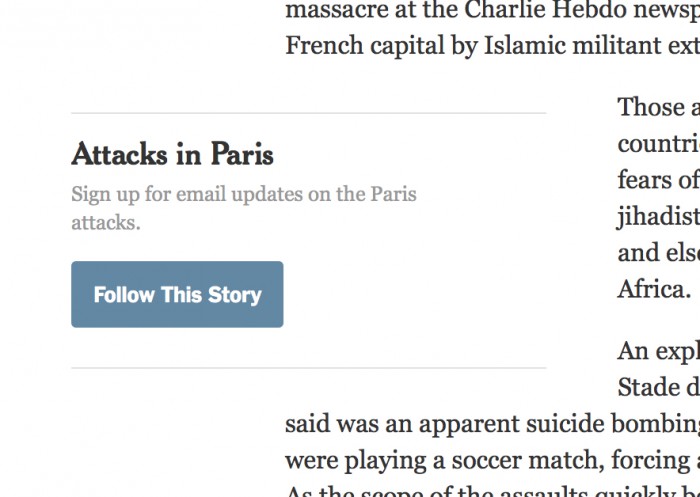
While you were looking at The New York Times’ coverage of the Paris terrorist attacks, you might have noticed something new: a field prompting you to sign up for email updates on the story.
 It’s the first time that the Times has given its readers the option of following a story at this scale via email. The experiment was spearheaded by the interactive news desk in collaboration with the foreign desk and audience development.
It’s the first time that the Times has given its readers the option of following a story at this scale via email. The experiment was spearheaded by the interactive news desk in collaboration with the foreign desk and audience development.
“It’s a great way to bring people back in who might just have come to the Times for the breaking news to understand what was happening,” said Ben Koski, deputy editor of interactive news. The email updates are also linking to Paris coverage across the Times (in the Arts section, for instance) that people wouldn’t necessarily come across on the homepage.
So far, the Times has sent out three email updates (“Latest on the Paris Attacks”). Much of the copy was adapted from morning and afternoon briefings created by Clifford Levy’s team. (Here’s an example.)“The frequency going forward is something we’re still deciding,” said Aaron Krolik, an interactive news journalist and developer. “We have to look at the numbers to see how the appetite has changed — if the effort [it takes to create the updates] is matched by the appetite for opening and reading these letters.” (New subscriptions to the newsletters have now been closed.)
It’s easy to understand the potential appeal of an email newsletter like this for a big breaking story. Even a casual digital news reader is seeing lots of stories and updates fly by on social media and elsewhere; a single iterated email that assembles it all in one place is a way could cut through the noise.But it’s hard to know how well it’s connected with readers; the Times wouldn’t share subscriber numbers or open rates, but described the response as positive. “We’ve gotten many replies thanking us for it,” Krolik said. It was also an opportunity for the Times to ask people if they had eyewitness information, news tips, or other feedback. Over the weekend, the team worked with the newsroom to put journalists in touch with readers who’d experienced the attacks. “It was powerful that we were able to feed these testimonies,” Krolik said.
While stressing that this was just a one-off experiment, Koski pointed out that it helps the Times think of new ways to involve readers in reporting, beyond simply collecting their email addresses and sending them updates. The interactive news team, which includes about 20 developers, has done a number of other projects involving reader submissions and interactions (recently, for instance, there was Transgender Today story wall).
“What we’re trying to capture is an expression of interest,” he said. “People have interest in this story, and we’re still a little unsure as to how to engage it, but it’s very exciting for us to have this group of users who have expressed a specific interest in the story, and we can reach out to them in more targeted ways.”